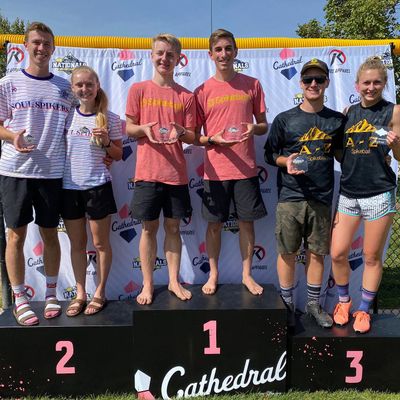CV Spikeball club founders win division title in national tournament

From “Shark Tank” to the top-rated lawn game sold on Amazon, Spikeball has become a staple of the American summer.
Now, after five years in the public eye, Spikeball has outgrown its summer-only interest and turned into a full-fledged sport.
This is where Spokane Valley’s Ryan Hagerty and Cooper Young have taken advantage of the wave of popularity.
Hagerty, a Central Valley graduate in 2020, and Young, a senior at CV, founded the school’s Spikeball club 13 months ago, the first of its kind for a Spokane-area high school.
Even with Hagerty at BYU for his freshman year, Young has taken the torch and continues to run the club – at least as much as he can with the restrictions in place.
Last year, CV and University High School played consistently against each other. This year has prevented those opportunities amid the pandemic.
Hagerty first became familiar with Spikeball several years ago when his mother bought him a dinky set. Young bought one after he saw it on the TV show “Shark Tank” in 2015, but it mainly collected dust.
It’s designed for four players, teams of two, who stand next to each other in a circle. Play happens on all 360 degrees of the net, and players can shift around each other during play. Players serve to their opponent directly across from them to start play. Serves are hit downward into the net. Players who receive the serve cannot hit it back into the net, rather they hit it toward their teammates who can either hit it into the net or back to their teammate who has to hit it into the net. Points are made when the ball hits the ground, the rim or bounces twice on the net. Teams can only score when they are serving and games are first to either 11, 15 or 21 points, win by two.
It took until early in 2019 before the two were on a youth group rafting trip where they played more competitively for the first time. After that, Hagerty and Young teamed up and have formed one of the best duos in the state.
They took that talent to a national tournament in Draper, Utah, over the last weekend in September. After winning 10 of the 11 matches they played, the two took first place in intermediate division of the 2020 Roundnet Nationals. They beat out two teams from Utah.
But the two were lucky to even find themselves on the field that weekend.
Throughout the year, teams must compete in what are called tour stops to qualify for national tournaments. Hagerty and Young had planned to attend them, including one in Salt Lake City, but they were all canceled. Young entered a giveaway and earned his and Hagerty’s spot in the tournament.
A quick message via social media to the event organizers and they were in.
Hagerty was already in the Draper area, just about 30 miles south in Provo. Young found a way to get to Draper and their tournament was on.
“A lot of stuff that came together,” Hagerty said.
Ryan Hagerty’s mother, Rachelle, was thrilled for the tournament win, but there is more to Spikeball than his successes around the net.
When Hagerty and Young attempted to start the Spikeball club at CV, the process was met with multiple roadblocks and setbacks.
“Not a lot of support at first, and a lot of discouraging moments where they were shot down quite a few times before they actually really were able to pull it off,” she said.
“The greatest joy is not necessarily them winning nationals but watching your child find something he loves and decides he wants to make more of it, and then being willing to jump through the hoops and cut through the red tape and fight for something that he believes in, and something that he’s passionate about.”
Appearing on ESPN multiple times a year, the original Spikeball game was created in 1989, but quickly lost its attractiveness.
It wasn’t until 2008, when current CEO Chris Ruder founded Spikeball Inc. with a new trademark and patent, that Spikeball began its upward trajectory.
Ruder helped market Spikeball as a game for everyone at any time and anywhere.
“It’s affordable, you can play with anybody, regardless of their skill level in any place, in sand, in water in grass or in a gym,” Hagerty said. “There’s a lot of thinking to it, there’s a lot of strategy.”
Floaties were created for the net so Spikeball can be played in the water, and the sport’s supporters positioned it to become a nationally televised event.
“I like how you can play with pretty much anyone,” Young said. “You can teach people how to play in five minutes and, they don’t have to be experts at the game to be able to have a fun time, even if it’s not very competitive. I like that aspect where I can play my friends, or I can go travel to tournaments and play super competitively.”